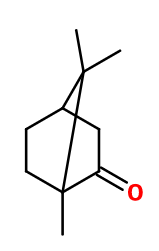
Photo credits: ScenTree SAS
| Company | Ingredient Name | ID | Comments | Naturality | Certifications | MOQ | Purity |
|---|---|---|---|---|---|---|---|
|
|
Camphre - 30gr | - |
Visit website
|
- | - | - | |
|
|
CAMPHRE | 205 |
Visit website
|
Huile essentielle | - | - |
General Presentation
-
CAS N° :
76-22-2 -
EINECS number :
200-945-0 -
FEMA number :
4513 -
FLAVIS number :
Donnée indisponible.
-
JECFA number :
Donnée indisponible. -
Volatility :
Head -
Price Range :
€€
Physico chemical properties
-
Appearance :
White solid -
Density :
0,992 -
Refractive Index @20°C :
Data not available. -
Optical rotation :
Data not available. -
Vapor pressure :
0,87 hPa @25°C (77°F) -
Flash Point :
64°C
-
Molecular formula :
C10H16O -
Molecular Weight :
152,23 g/mol -
Log P :
2,41 -
Fusion Point :
176°C -
Boiling Point :
204°C -
Detection Threshold :
Donnée indisponible.
Chemistry & Uses
Uses in perfumery :
Camphor is used for a fresh and terpenic effect in all types of compositions.
Year of discovery :
1904
Natural availability :
Camphor is found in many plants such as basil (camphorated chemotype), camphor sage and Cardamom EO among others. The Camphor tree HE (same species as HoWood EO) remains its main source in its natural state.
Isomerism :
There are two enantiomers of Camphor, both very present in nature. The most common is Camphor (+), dextrorotatory. It is very often this one that is used in perfumery. Citral and Isocyclocitral® are constitutional isomers of Camphor. Their smell is however very different: one is citraly, the other is green.
Synthesis precursor :
Camphor is an intermediate in the synthesis of Camphene and Borneol, among others.
Synthesis route :
Camphor is produced by a fractional distillation of Camphor Leaf EO. Its synthesis is made by dehydration of isoborneol, which has been synthesized from Isobornyl acetate. This dehydrogenation is done thanks to a copper catalysis.
Stability :
Stable in perfumes and diverse functional bases
Other comments :
Camphor is a 'trigeminal' raw material. This means that it involves the trigeminal nerve, responsible for a motor and sensitive function for humans. In the case of Camphor, smelling it gives the nose a sensation of cold.
Regulations & IFRA
Allergens :
This ingredient is classified as an allergen under European Regulation 2023/1545, dated August 26, 2023.
Its presence must therefore be declared on product labels when it exceeds 0.001% in leave-on products and 0.01% in rinse-off products.
IFRA 51th :
This ingredient is not restricted for the 51th amendment

